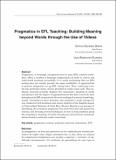| dc.contributor.author | Olivares, Cinthya | |
| dc.contributor.author | Barrantes, Lena | |
| dc.date.accessioned | 2020-09-23T21:31:05Z | |
| dc.date.available | 2020-09-23T21:31:05Z | |
| dc.date.issued | 2016 | |
| dc.identifier.issn | 1659-1933 | |
| dc.identifier.uri | http://hdl.handle.net/11056/18239 | |
| dc.identifier.uri | https://revistas.ucr.ac.cr/index.php/rlm/article/view/27697 | |
| dc.description.abstract | Pragmatics, a seemingly unexplored area by most EFL teachers nowadays, offers a number of language competencies in order to convey and understand meaning successfully. It is worth mentioning that an EFL setting does not usually provide the same availability of opportunities to practice pragmatics as an ESL setting does. Thus, contextual cues, for this particular study, will be provided by audio-visual aids. This authentic material certainly displays the connotative meaning of words and phrases and the degree of appropriateness that have currently been downplayed in EFL scenarios by the over teaching of syntactic knowledge, mostly. Grounded on these premises, this qualitative study emerged. It was conducted with freshman and junior students of the English majors at Universidad Nacional of Costa Rica, Brunca Branch as an attempt at identifying the treatment pragmatics has received in the oral expression courses, and devising several techniques on how to help students grasp the connotative meaning of words and phrases derived from contextual factors found in authentic audio-visual aids. | es_ES |
| dc.description.abstract | La pragmática, un área que pareciera no ser explorada por muchos profesores de inglés como lengua extranjera hoy en día, ofrece un número de competencias lingüísticas que ayudan a expresar y entender el significado exitosamente. Un ambiente de aprendizaje de este tipo no provee la misma disponibilidad de oportunidades para practicar la pragmática como lo es un ambiente de aprendizaje del inglés como segunda lengua. Para este estudio en particular, se propuso un contexto a partir del uso de recursos audiovisuales auténticos. Este material contiene el signifcado connotativo de las palabras y frases, así como el grado de conveniencia que ha sido actualmente subestimado debido a la sobreenseñanza del conocimiento sintáctico. Este estudio cualitativo emerge fundamentado en estas premisas. Se llevó a cabo con estudiantes de primer y tercer año de las carreras de inglés de la Universidad Nacional de Costa Rica, Sede Regional Brunca, como un intento de identifcar el tratamiento que ha recibido la pragmática en los cursos de expresión oral, y así también desarrollar varias técnicas para ayudar a los estudiantes a comprender el signifcado connotativo de las palabras y frases derivadas de factores contextuales encontrados en recursos audiovisuales auténticos. | es_ES |
| dc.description.sponsorship | Universidad de Costa Rica | es_ES |
| dc.language.iso | eng | es_ES |
| dc.publisher | Escuela de Lenguas Modernas, Universidad de Costa Rica | es_ES |
| dc.rights | Acceso abierto | es_ES |
| dc.rights | Attribution-NonCommercial-NoDerivatives 4.0 Internacional | * |
| dc.rights.uri | http://creativecommons.org/licenses/by-nc-nd/4.0/ | * |
| dc.source | Revista de Lenguas Modernas no.25 223-236 2016 | es_ES |
| dc.subject | INGLES | es_ES |
| dc.subject | PRAGMATISMO | es_ES |
| dc.subject | MÉTODOS DE ENSEÑANZA | es_ES |
| dc.subject | SEDE REGIONAL BRUNCA (UNIVERSIDAD NACIONAL (COSTA RICA)) | es_ES |
| dc.subject | ENGLISH | es_ES |
| dc.subject | PRAGMATISM | es_ES |
| dc.subject | TEACHING METHODS | es_ES |
| dc.title | Pragmatics in EFL teaching building meaning beyond words through the use of videos | es_ES |
| dc.type | http://purl.org/coar/resource_type/c_6501 | es_ES |
| dc.description.procedence | Sede Regional Brunca, Campus Pérez Zeledón | es_ES |
| dc.identifier.doi | 10.15517/RLM.V0I25.27697 | |


